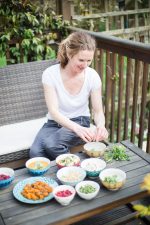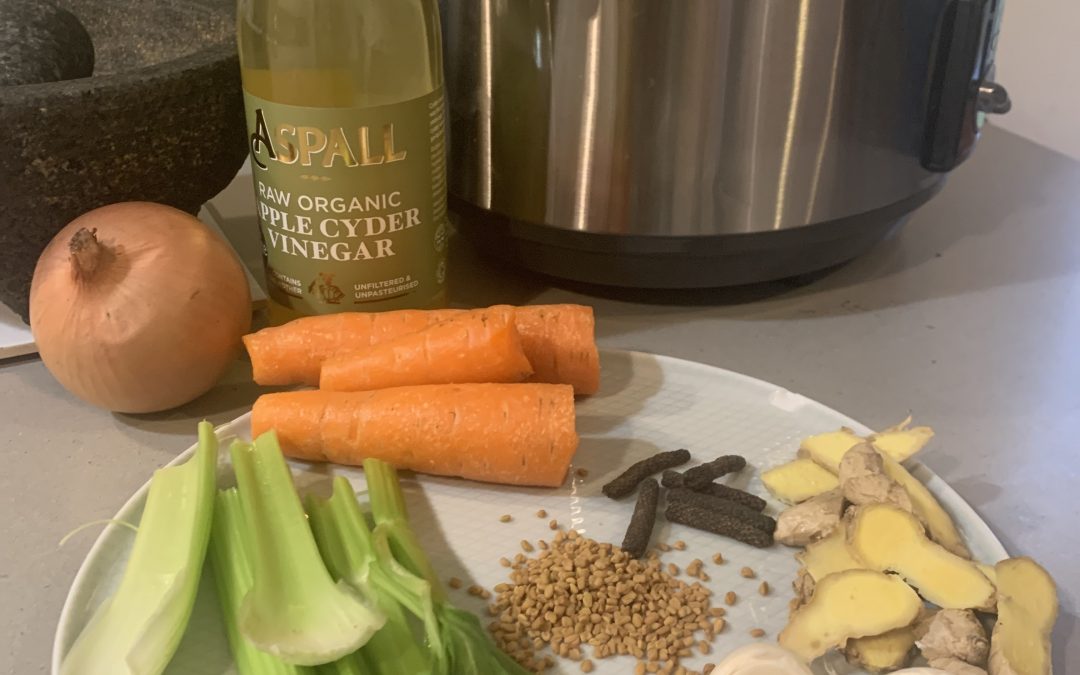Soothing, immunity boosting goodness. For centuries, bone broth has been reputed in many cultures to hold an abundance of health giving properties. It’s easily digested and is reported to reduce inflammation in the gut as well as supporting the immune system and promoting joint health. It’s not a ‘must have super food’…if there is such a thing. It’s an age old-tradition of slow cooked, nourishing food.
Don’t be put off by the cooking time. Although it’s best to simmer at a low temperature for at least 6-8 hours, the preparation time is minimal. I try to make a batch every week, especially in winter. I use it for the basis of soups, rices dishes like risotto or pilaf. If you’re not going to use it straight away, you can store it in the freezer for a couple of months, but you’ll definitely use it before then.
Ingredients:
- Organic chicken carcass or other organic meat or fish bones.
- 2 tsp coriander seeds
- 1tsp fenugreek seeds
- 4-5 crushed Long peppercorns (pippali)…or if your done have those……
- 1 tsp black peppercorns or a few crushed long peppercorns.
- A thumb sized piece of ginger, sliced.
- Enough water to cover the bones completely.
- 3-4 Garlic cloves
- A few sticks of celery
- 1 onion roughly chopped
The how to:
Add all the ingredients to a pot and simmer on a very low heat for 6-8 hours.
Alternatively you can use a slow cooker. Cook on the lowest setting for about 8 hours.
Strain through a muslin.
This can be used as the base for soups or stews or drunk on its own.
Add some fresh ginger, lime juice and a small handful of coriander leaves. Drink on its own or use as the base for a delicious Japanese noodle soup.
Why it’s so good
For centuries bone broth has been consumed for its easy to digest nutrition and therapeutic qualities. Reported to boost the immune system and treat digestive conditions such as hyperacidity, colitis and Crohn’s disease.
Balancing the Doshas
It’s pretty much perfect for all three doshas. You can adapt it to suit the doshas but adding additional ingredients one you have made your broth.
Balancing for Vata Dosha
Once you have made your bone broth, you could add a little rice, a few potatoes or barley – ensure you cook the barley until soft and throughly cooked. Add a little more grated garlic and ginger, salt and pepper and some vegetables to make a nourishing soup.
Balancing the Pitta Dosha
The above would also be perfect for Pitta dosha. May be add some bitter greens – kale, winter cabbage, white beans. Easy on the garlic, ginger and salt. Pippali (or long pepper) adds warmth but not the pungent spiciness that Pitta doshas generally goes for.
Balancing the Kapha Dosha
The key to balancing Kapha dosha is keep it light, nourishing and warming.
Try adding grated garlic and ginger, a squeeze of lime and even a little chilli stoke the digestive fire. For a more substantial meal, you could add some noodles and light vegetables: spinach, pack choi or green cabbage.
All three recipes are nourishing, and gentle on the digestive system. Perfect for winter if the digestions feeling a little sluggish.
Vegan Broth
You could try making a vegan broth by using sea vegetables with the above ingredients. I like to use a few strips of sea kelp (kombu).
This doesn’t take as long to make. Add all the ingredient to a pot or slow cooker and simmer for an hour or so. Strain and use as the base for a light nourishing soup.
If you’d like to find out more about seasonal eating and eating for your Ayurvedic type, you can book for our Winter Workshop with Clare on Friday 4th February at 7.30pm. Follow the link HERE to book.

Clare is an Ayurvedic Nutrition and Massage Therapist at Lotus Studio, Highams Park.

